Entering the Ho Chi Minh Mausoleum requires understanding specific procedures, including security checks and queueing. SIXT.VN offers valuable guidance and services to ensure a respectful and seamless visit, helping you navigate these processes smoothly. Discover the best way to experience this historical site with ease.
1. What Makes The Ho Chi Minh Mausoleum A Must-See Destination?
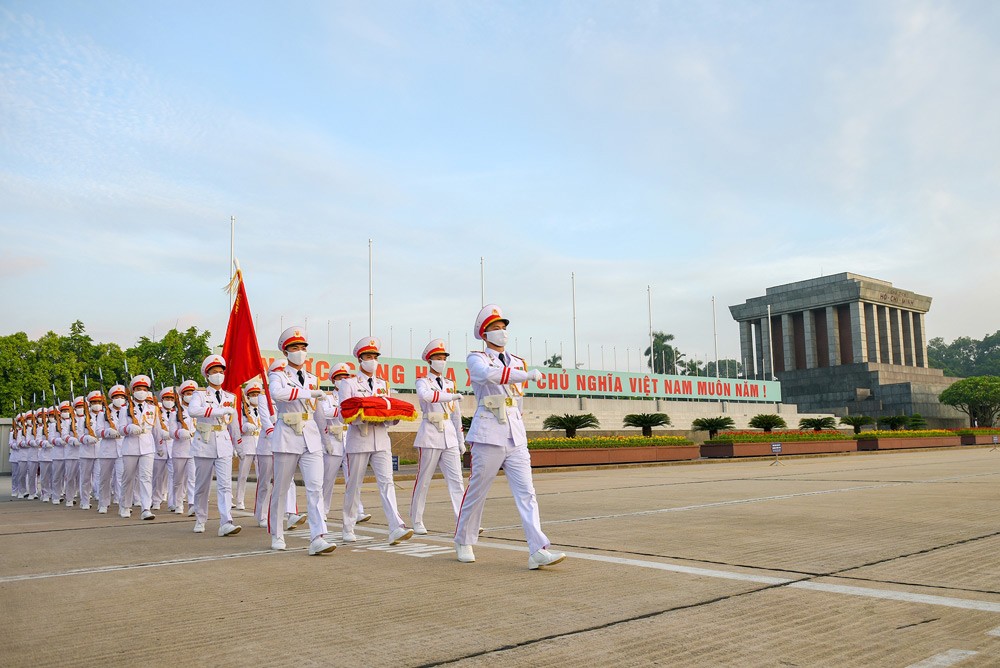 Ho Chi Minh Mausoleum. What Makes The Ho Chi Minh Mausoleum A Must-See Destination?
Ho Chi Minh Mausoleum. What Makes The Ho Chi Minh Mausoleum A Must-See Destination?
The Ho Chi Minh Mausoleum is more than a tomb; it’s a symbol, a pilgrimage site, and a unique landmark. But what makes the Ho Chi Minh Mausoleum a must-see destination that attracts countless visitors annually? It’s a mix of deep history, impressive architecture, and unique cultural experiences.
1.1. A Symbol Of National Unity
The Ho Chi Minh Mausoleum represents Vietnam’s independence and honors Ho Chi Minh, who is seen as the father of modern Vietnam. He led the country through its struggle for freedom. The mausoleum shows the nation’s thanks and respect for his leadership and embodies the unified Vietnam he fought for. Located in Ba Dinh Square, where he declared Vietnam’s independence, enhances its symbolism.
1.2. A Pilgrimage Destination
Visiting the Ho Chi Minh Mausoleum is a pilgrimage for many Vietnamese. It’s an emotional experience to honor “Uncle Ho,” who led them to independence. Long lines of Vietnamese visitors from all walks of life wait to enter and pay their respects. This palpable sense of respect and national pride makes the mausoleum unique.
1.3. Architectural Importance
The Ho Chi Minh Mausoleum is also known for its architecture. Inspired by Lenin’s Mausoleum in Moscow, it includes Vietnamese elements like the sloping roof. The grand structure, made of granite and marble, dominates Ba Dinh Square. Its design reflects the seriousness of its purpose and makes a strong visual impact. The use of Vietnamese materials in a Soviet-style building shows the nation’s complex history.
1.4. A One-Of-A-Kind Experience
Visiting the Ho Chi Minh Mausoleum offers a unique look into Vietnamese culture and history. The experience is carefully managed, from the dress code to the silent walk inside. It’s a chance to see the deep respect Vietnamese people have for Ho Chi Minh and understand the events that shaped Vietnam. The appeal of “What Makes The Ho Chi Minh Mausoleum A Must-See Destination?” lies in its building and its emotional and historical context. It’s a powerful experience that goes beyond typical tourism.
2. How To Plan Your Visit: Essential Information
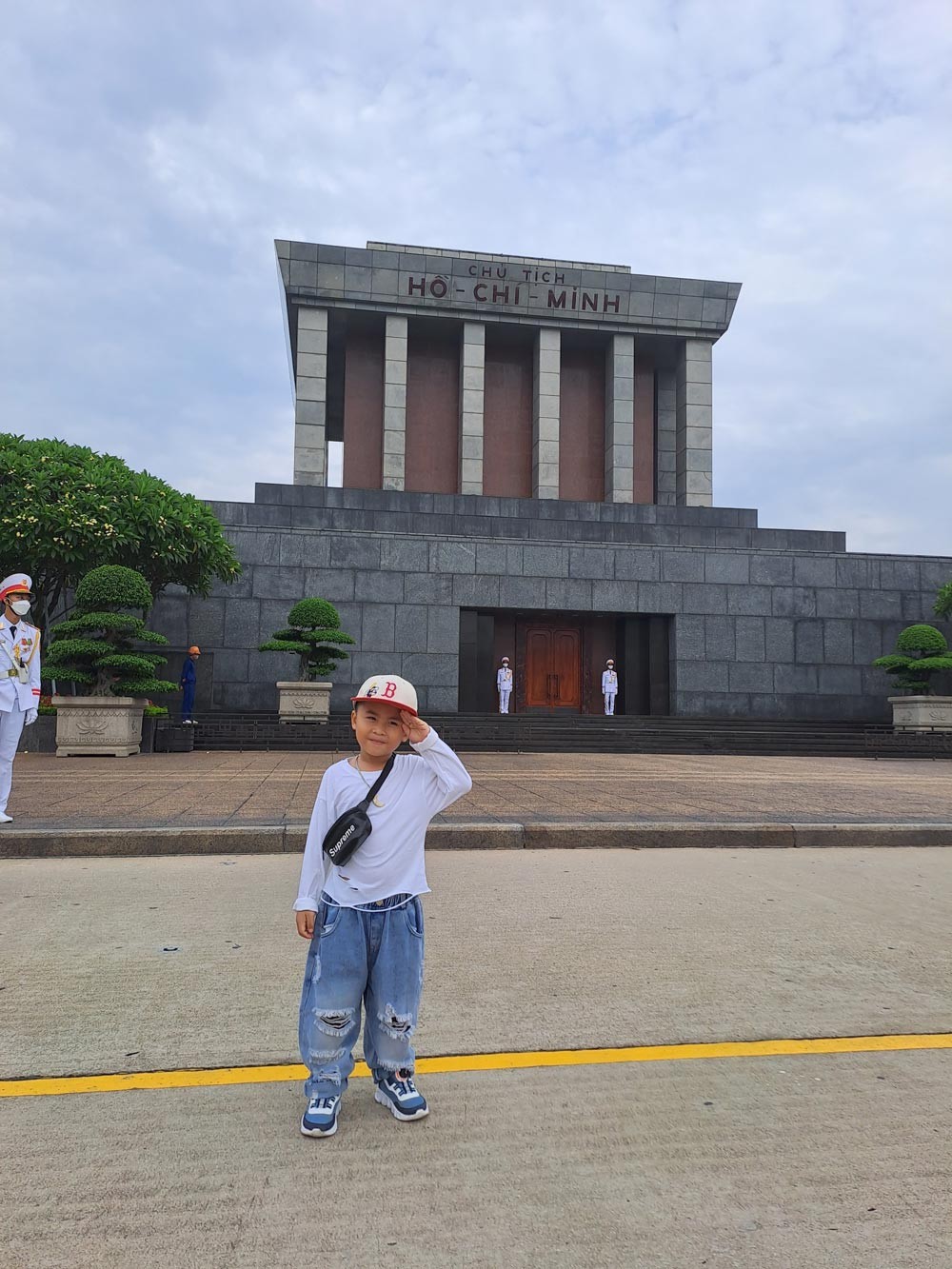 Ho Chi Minh Mausoleum. How To Plan Your Visit: Essential Information Source: Dao Thi Ngoc Truc
Ho Chi Minh Mausoleum. How To Plan Your Visit: Essential Information Source: Dao Thi Ngoc Truc
To make sure your visit to the Ho Chi Minh Mausoleum goes smoothly, planning and knowing the details are key. Here’s what you should know:
2.1. Understanding The Ho Chi Minh Mausoleum Opening Hours
Knowing the Ho Chi Minh Mausoleum opening hours is important because they are limited and can change.
- Current Schedule: Usually, the mausoleum is open to the public on Tuesday, Wednesday, Thursday, Saturday, and Sunday mornings. It’s usually closed on Mondays and Fridays.
- Morning Visits Only: Visits are limited to the morning, typically from 7:30 AM to 11:00 AM during the summer (April to September) and from 8:00 AM to 11:00 AM during the winter (October to March).
- Annual Maintenance: The mausoleum closes for about two months each year, usually in September-October or October-November, for maintenance.
- Arrive Early: Because of the limited Ho Chi Minh Mausoleum opening hours and the site’s popularity, long lines can form. Arriving early is recommended to reduce your wait.
2.2. Is There A Ho Chi Minh Mausoleum Entrance Fee?
The good news is that there’s no Ho Chi Minh Mausoleum entrance fee. Entry is free for both Vietnamese and foreign visitors, making it very accessible despite its importance. You do not need to buy any Ho Chi Minh Mausoleum tickets.
2.3. How Long Does It Take To Tour The Ho Chi Minh Mausoleum?
When planning, you might ask, “How long does it take to tour the Ho Chi Minh Mausoleum?”
- Total Visit Time: While the time inside the mausoleum is short, plan for about 1 to 2 hours for the entire visit. This includes waiting in line, security, walking through the mausoleum, and exiting.
- Queue Time: The queue length varies depending on the day, time of year, and time of day. Expect longer waits on weekends, holidays, and during peak season.
2.4. Location And Directions
The Ho Chi Minh Mausoleum is in Ba Dinh Square in central Hanoi.
- Address: 2 Hung Vuong, Dien Bien, Ba Dinh District, Hanoi.
- Direction: https://maps.app.goo.gl/T118hiVTJbJB7PHFA
- Transportation:
- Walking: If you’re in the Old Quarter or near Hoan Kiem Lake, you can walk, but it may take 30-45 minutes.
- Taxi/Ride-hailing Apps: Taxis and Grab are easy to find and a convenient way to get to the square.
- Bus: Many public bus routes go to Ba Dinh Square. You can find routes and schedules on a local bus app or website.
Knowing the Ho Chi Minh Mausoleum opening hours, entrance fee details, and how to get there helps you plan a smooth visit. Remember to arrive early, dress respectfully, and prepare for a unique experience. SIXT.VN offers convenient transportation options and travel advice to simplify your trip.
3. What Can I Expect Inside The Ho Chi Minh Mausoleum?
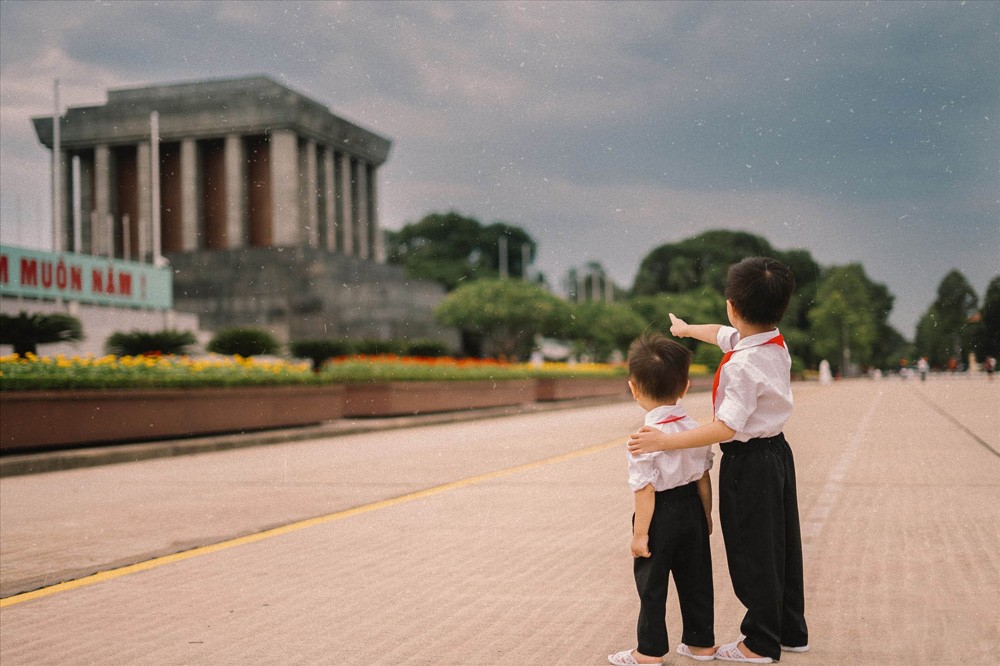 Ho Chi Minh Mausoleum. What Can I Expect Inside The Ho Chi Minh Mausoleum?
Ho Chi Minh Mausoleum. What Can I Expect Inside The Ho Chi Minh Mausoleum?
Visiting the Ho Chi Minh Mausoleum is unique and moving for many. Knowing what to expect inside helps you prepare for the solemnity and formality.
3.1. The Queue Experience
The journey often starts with a queue, which can be long during peak season, weekends, and holidays.
- Be Patient: Be ready to wait, sometimes for over an hour. The line moves steadily but slowly.
- Respectful Behavior: Maintain a respectful demeanor while waiting. Keep conversations quiet and avoid disruptions. The queue is a time for reflection.
3.2. Security Screening
Before entering, you’ll go through a security checkpoint.
- Security Procedures: Expect standard security checks like at an airport, including bag checks and metal detectors.
- Restricted Items: Cameras, phones, large bags, food, and drinks are not allowed. You’ll need to leave these at a designated area before joining the queue.
3.3. Entering The Interior
Stepping inside the Ho Chi Minh Mausoleum means entering a place of great solemnity.
- Solemn Atmosphere: Silence is strictly enforced. Guards are stationed to ensure respectful behavior.
- Single File Procession: Visitors enter in a single file, walking slowly past Ho Chi Minh’s embalmed body. The atmosphere is quite moving.
3.4. What’s The Ho Chi Minh Mausoleum Like Inside?
The main part of the experience is viewing Ho Chi Minh’s body. Here’s what to expect inside the Ho Chi Minh Mausoleum:
- The Viewing: Ho Chi Minh’s body is in a glass case in a dimly lit, climate-controlled room. The setting is for reverence and contemplation. Four military honor guards stand at each corner of the casket.
- Brief and No Stopping: The viewing is brief, and you can’t stop as you walk past. The line moves continuously, allowing everyone to pay respects. It’s a fleeting but lasting moment.
3.5. Exiting The Interior
After the main chamber, you’ll continue through the complex.
- Respectful Exit: The silent and respectful atmosphere continues as you exit through the gardens.
- Collecting Belongings: If you checked items, you’ll be directed to where you can collect them. The system is efficient.
Visiting inside the Ho Chi Minh Mausoleum is a unique look into Vietnam’s history and the legacy of its leader. By understanding the procedures and acting respectfully, you ensure a meaningful visit.
4. What Should I Wear To The Ho Chi Minh Mausoleum: Dress Code Guidelines
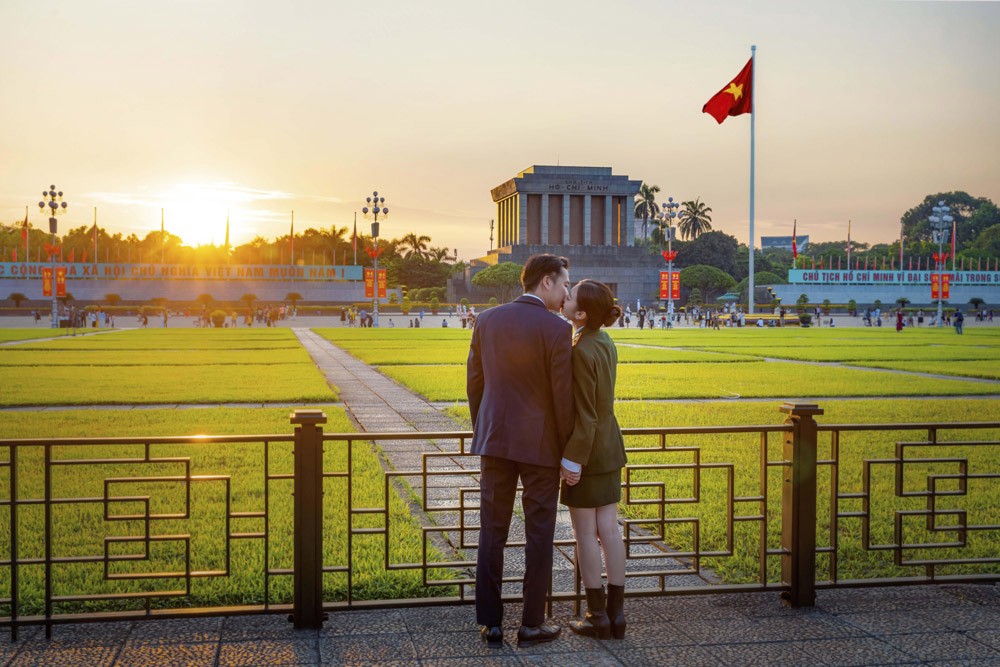 Ho Chi Minh Mausoleum. What Should I Wear To The Ho Chi Minh Mausoleum: Dress Code Guidelines Source: Pham Trung Hien
Ho Chi Minh Mausoleum. What Should I Wear To The Ho Chi Minh Mausoleum: Dress Code Guidelines Source: Pham Trung Hien
Visiting the Ho Chi Minh Mausoleum requires following a strict dress code. Understanding these guidelines ensures a smooth and respectful visit. Many visitors ask, “What should I wear to the Ho Chi Minh Mausoleum?” Here’s what you need to know:
4.1. A Strict Dress Code
The Ho Chi Minh Mausoleum is a place of deep respect. A strict dress code is enforced to maintain its solemnity. This isn’t just a suggestion but a requirement.
- Respectful Attire: Dress like you would for a formal event or place of worship. Your clothing should reflect the site’s seriousness.
4.2. Specific Guidelines
Here’s what is and isn’t acceptable:
- Covered Shoulders and Knees: This is the most important rule. Both men and women must cover their shoulders and knees. No sleeveless shirts, tank tops, shorts, or short skirts. Long pants, capri pants (covering the knees), or longer skirts are appropriate.
- No Hats or Sunglasses: Hats and sunglasses must be removed as a sign of respect.
- No Revealing Clothing: Avoid revealing or disrespectful clothing, including low-cut tops, sheer fabrics, or clothes with offensive slogans.
4.3. Consequences of Non-Compliance
It’s important to take the dress code seriously.
- Denied Entry: Visitors not meeting the dress code will be denied entry. Guards enforce these rules strictly.
- Avoid Disappointment: Plan your outfit to avoid disappointment. It’s easier to dress right from the start.
4.4. Tips For Dressing Appropriately
- Carry a Scarf or Shawl: A scarf is versatile for covering shoulders or knees if needed.
- Wear Layers: If unsure about the weather or your outfit, wear layers.
- Plan Ahead: Plan to dress appropriately when visiting the Ho Chi Minh Mausoleum.
Following the dress code shows respect and ensures a smooth visit. It demonstrates understanding of the site’s cultural significance.
5. Is It Possible To Go Inside The Ho Chi Minh Mausoleum?
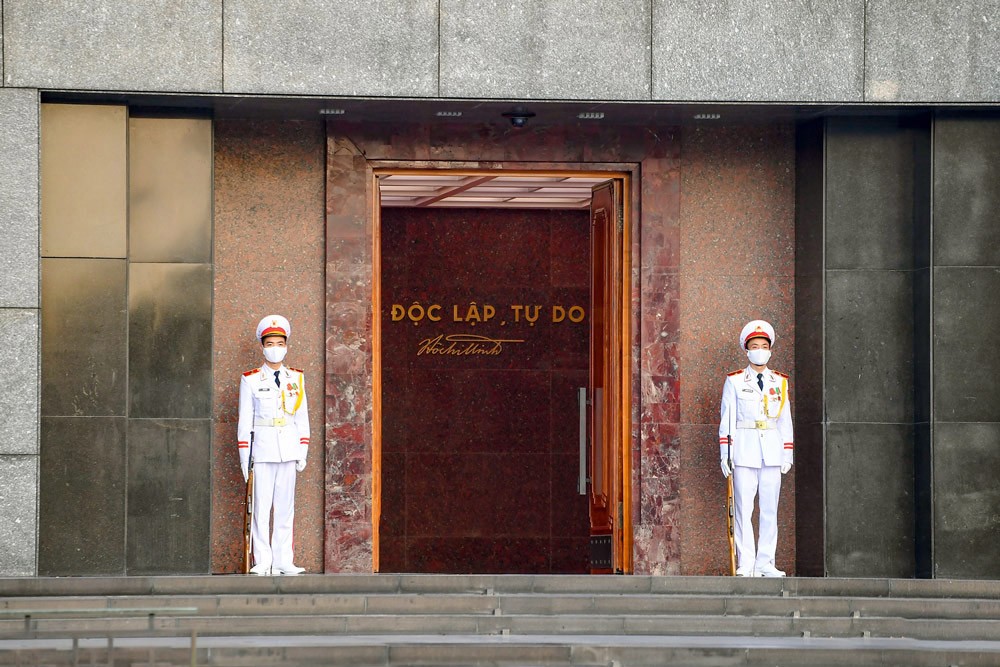 Ho Chi Minh Mausoleum. Is It Possible To Go Inside The Ho Chi Minh Mausoleum?
Ho Chi Minh Mausoleum. Is It Possible To Go Inside The Ho Chi Minh Mausoleum?
A common question is, “Is it possible to go inside the Ho Chi Minh Mausoleum?” Yes, but with restrictions to maintain respect.
5.1. Yes, But With Restrictions
Visitors can enter the Ho Chi Minh Mausoleum to view Ho Chi Minh’s body. However, this isn’t casual sightseeing. Strict rules emphasize respect and order. These rules honor Ho Chi Minh. The answer to “Is it possible to go inside the Ho Chi Minh Mausoleum?” is yes, but follow the rules.
5.2. A Controlled Environment
The interior is carefully controlled to preserve Ho Chi Minh’s body.
- Temperature: It’s kept cool to aid preservation. You’ll feel a chill.
- Guards: Military guards maintain order, adding to the solemnity. Four guards stand at the casket corners.
5.3. A Brief And Solemn Experience
Your time inside will be brief but impactful.
- No Stopping: Visitors can’t stop inside. You’ll walk slowly past the body in a continuous procession.
- Respectful Silence: Silence is enforced. Talking or disruptive behavior is prohibited.
- A Moment of Reflection: Viewing Ho Chi Minh’s body offers reflection on his legacy. It’s a unique opportunity to witness Vietnamese history.
Entering the Ho Chi Minh Mausoleum is unlike other attractions. By understanding restrictions and respecting the environment, you’ll appreciate this important site.
6. What Else Can You Explore In Ba Dinh Square?
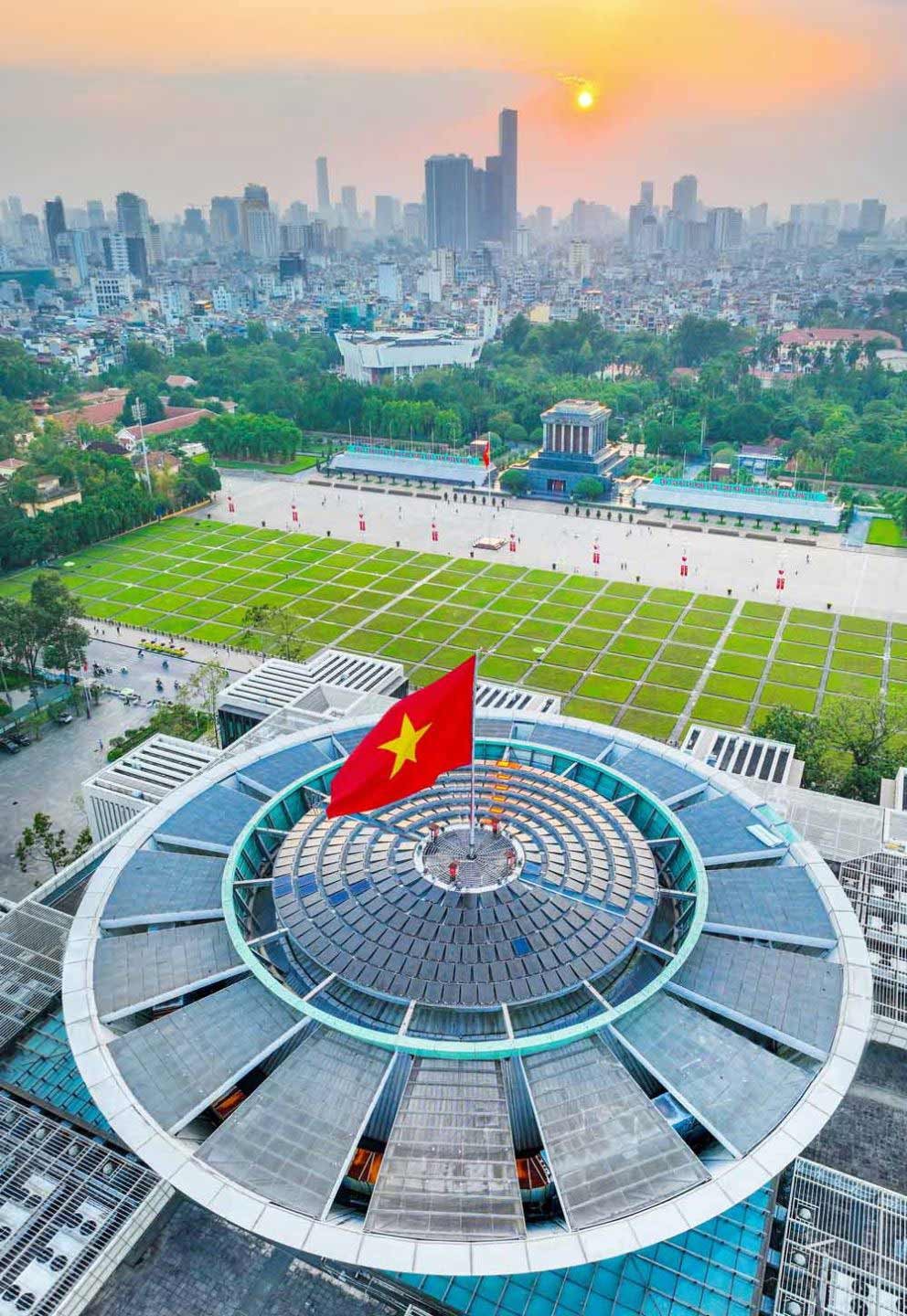 Ho Chi Minh Mausoleum. What Else Can You Explore In Ba Dinh Square? Source: Nguyen Hoang Ha
Ho Chi Minh Mausoleum. What Else Can You Explore In Ba Dinh Square? Source: Nguyen Hoang Ha
While the Ho Chi Minh Mausoleum is a highlight, Ba Dinh Square offers other historical and cultural attractions. You can spend hours exploring this area.
6.1. Discover Ba Dinh Square
Before or after the Mausoleum, appreciate Ba Dinh Square. This square is where Ho Chi Minh declared Vietnam’s independence on September 2, 1945. Standing here, you feel the history. The square is used for national events.
6.2. Flag Raising And Lowering Ceremonies
The daily flag ceremonies are a spectacle. The military honor guard performs these with precision.
- Morning Ceremony: The flag is raised at around 6:00 AM in summer and 6:30 AM in winter.
- Evening Ceremony: The flag is lowered at 9:00 PM.
Witnessing these ceremonies adds to your visit.
6.3. The One Pillar Pagoda
Near the Ho Chi Minh Mausoleum is the One Pillar Pagoda (Chùa Một Cột). This temple is known for its unique architecture. It’s built on a single pillar in a lotus pond, resembling a lotus blossom. Dating back to the 11th century, it’s an icon of Hanoi.
6.4. Ho Chi Minh Museum Visit
To understand Ho Chi Minh’s life, visit the Ho Chi Minh Museum. It houses artifacts and documents about “Uncle Ho” and Vietnam’s struggle for independence. It provides context for the Ho Chi Minh Mausoleum.
6.5. Ho Chi Minh’s Stilt House And Presidential Palace Tour
Behind the Mausoleum, explore where Ho Chi Minh lived.
- Ho Chi Minh’s Stilt House: This simple house shows Ho Chi Minh’s lifestyle. You can see where he worked and slept.
- Presidential Palace: Admire its French colonial architecture from outside. It reminds us of Vietnam’s colonial past.
Exploring these sites completes your understanding of Ho Chi Minh’s life and Ba Dinh Square. It’s a journey through time that deepens your appreciation for Vietnam.
The Ho Chi Minh Mausoleum is a symbol of Vietnam’s past and a place of reverence. It offers a chance to connect with history and understand Ho Chi Minh’s legacy. Visiting the mausoleum and exploring Ba Dinh Square leaves a lasting impression. We encourage you to add this landmark to your Hanoi itinerary.
To make your visit even better, consider SIXT.VN. We craft experiences that go beyond typical tours. Our local experts provide unique insights into the historical context of sites like the Mausoleum. With SIXT.VN, you travel confidently, knowing every detail is arranged by a team dedicated to unforgettable memories.
Ready to explore Vietnam’s history? Explore our range of tour packages and let us help you design your perfect adventure.
7. Streamlining Your Visit: How SIXT.VN Can Help
Planning a visit to the Ho Chi Minh Mausoleum involves understanding various procedures, from security checks to dress codes. SIXT.VN can assist in making your visit smooth and respectful by providing essential information and services.
7.1. Comprehensive Travel Advice
SIXT.VN offers detailed advice on the Ho Chi Minh Mausoleum’s opening hours, dress code, and rules of conduct. This ensures you are well-prepared and avoid any entry issues.
7.2. Convenient Transportation Options
Getting to Ba Dinh Square is easy with SIXT.VN’s transportation services. We offer airport transfers, taxi services, and private car hires, ensuring you arrive on time and stress-free.
7.3. Tailored Tour Packages
Enhance your experience with SIXT.VN’s tailored tour packages that include visits to the Ho Chi Minh Mausoleum and other significant sites in Hanoi. These packages are designed to provide a deeper understanding of Vietnam’s history and culture.
7.4. Local Expertise
Benefit from the knowledge of local guides who can offer unique insights and historical context, making your visit more meaningful. SIXT.VN ensures you have access to the best local expertise.
7.5. Accommodation Assistance
SIXT.VN helps you find the perfect accommodation near Ba Dinh Square, ensuring you are close to the Mausoleum and other attractions. We offer a range of options to suit your budget and preferences.
8. What Are The Security Procedures For Entering The Mausoleum?
Navigating the security checks at the Ho Chi Minh Mausoleum is a key part of the entry process. Here’s what you need to know:
8.1. Initial Screening
Before entering the mausoleum complex, visitors undergo an initial screening. This includes a visual check of your attire to ensure it meets the dress code requirements.
8.2. Bag Checks
All bags are subject to inspection. It’s advisable to bring only essential items to expedite the process. Prohibited items include:
- Cameras and recording devices
- Mobile phones
- Large bags and backpacks
- Food and beverages
- Flowers and gifts
8.3. Metal Detectors
Visitors must pass through metal detectors. Remove any metal objects from your pockets to avoid delays.
8.4. Prohibited Items Storage
A designated storage area is available for items not allowed inside the mausoleum. This service is secure and free of charge.
8.5. Respectful Conduct
During the security check, maintain a respectful demeanor. Follow the instructions of security personnel at all times.
9. What Are The Queueing Procedures At The Ho Chi Minh Mausoleum?
The queueing process at the Ho Chi Minh Mausoleum requires patience and adherence to specific guidelines:
9.1. Joining The Queue
The queue typically forms early in the morning. Arriving before the opening time is recommended to minimize wait times.
9.2. Queue Etiquette
- Maintain silence and respect throughout the queue.
- Avoid pushing or cutting in line.
- Follow the directions of the staff and security personnel.
- Keep a reasonable distance from the person in front of you.
9.3. Queue Movement
The queue moves at a steady but slow pace. Be prepared to stand for an extended period.
9.4. Weather Considerations
Depending on the time of year, the weather can be hot and humid. Bring water and wear sunscreen to stay comfortable.
9.5. Special Assistance
If you require special assistance due to mobility issues or other concerns, inform a staff member. They will provide appropriate support.
10. Key Tips For A Smooth Visit To The Ho Chi Minh Mausoleum
To ensure a seamless and respectful visit to the Ho Chi Minh Mausoleum, consider these tips:
10.1. Plan Your Visit
Check the Ho Chi Minh Mausoleum opening hours in advance. Arrive early to avoid long queues.
10.2. Dress Code Compliance
Adhere to the strict dress code: covered shoulders and knees, no hats or sunglasses.
10.3. Security Awareness
Be aware of the security procedures and prohibited items. Store unnecessary belongings in advance.
10.4. Respectful Conduct
Maintain silence and respect throughout the visit. Follow the instructions of staff and security personnel.
10.5. Hydration
Bring water to stay hydrated, especially during hot weather.
10.6. Photography Restrictions
Photography is not allowed inside the mausoleum. Respect this rule and avoid taking pictures.
10.7. Additional Attractions
Explore Ba Dinh Square and nearby attractions to make the most of your visit.
10.8. Transportation Arrangements
Arrange transportation in advance to ensure a smooth arrival and departure.
10.9. Local Customs
Familiarize yourself with local customs and traditions to show respect for Vietnamese culture.
10.10. Professional Guidance
Consider hiring a local guide for deeper insights into the history and significance of the mausoleum.
FAQ About Visiting The Ho Chi Minh Mausoleum
Here are some frequently asked questions to help you plan your visit to the Ho Chi Minh Mausoleum:
1. What are the Ho Chi Minh Mausoleum opening hours?
The mausoleum is typically open on Tuesday, Wednesday, Thursday, Saturday, and Sunday mornings. It is closed on Mondays and Fridays.
2. Is there an entrance fee?
No, entry to the Ho Chi Minh Mausoleum is free.
3. What is the dress code?
Visitors must wear respectful attire, covering their shoulders and knees. No hats or sunglasses are allowed.
4. What items are prohibited inside the mausoleum?
Prohibited items include cameras, mobile phones, large bags, food, and drinks.
5. How long does it take to visit the mausoleum?
Allocate approximately 1 to 2 hours for the entire visit, including queueing and security checks.
6. Can I take photographs inside the mausoleum?
No, photography is not allowed inside the mausoleum.
7. Is there a storage area for prohibited items?
Yes, a secure storage area is available for items not allowed inside.
8. What should I expect during the security check?
Expect bag checks and metal detector screenings.
9. How early should I arrive?
Arrive early to minimize wait times, especially during peak season.
10. Can SIXT.VN help with transportation to the mausoleum?
Yes, SIXT.VN offers various transportation options, including airport transfers and private car hires.
By following these procedures and tips, you can ensure a respectful and meaningful visit to the Ho Chi Minh Mausoleum. SIXT.VN is here to assist you with comprehensive travel advice and convenient services, making your journey to this iconic site smooth and memorable. Contact us today to learn more about our tailored tour packages and transportation options.
Address: 260 Cau Giay, Hanoi, Vietnam
Hotline/Whatsapp: +84 986 244 358
Website: SIXT.VN



